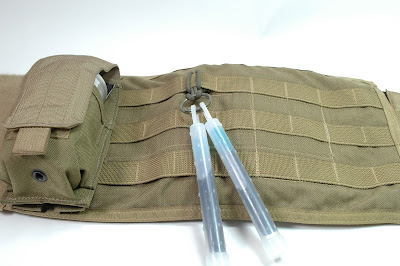Passive means include items like IR flags, squares, unit patches, ID patches, etc. Active means include items like this week's product of the week: The Neptune Beacon from CEJAY Engineering. Designed to fill a number of roles in order to reduce the overall load today's warrior has to carry in order to complete the mission at hand.
Information from the manufacturer:
The Neptune beacon is a multi purpose multi function signal light developed to provide the soldier and officer several ID and illumination tools in one compact package. The Neptune light produces a wide, variable-output, flashing or constant on, IR, Blue or White signal. In flashing IR mode, the intense brightness of the Neptune’s signal allows it to be used as either an individual or vehicle Combat ID marker. In Blue or White signal mode, the beacon can be used as either a land or water distress signal.
The Neptune high impact plastic housing and sealed electronics are engineered to withstand harsh environments and chemical exposure. Powered by one CR123A, the Neptune is lightweight, rugged, versatile and submersible to 150 feet making the beacon superbly suited for water to land deployment and special operations applications.
Despite its small size, all Neptune functions can be controlled with one hand even when gloved. The Neptune’s signal is turned ON or OFF simply by rotating the battery cap. The single mode selection button allows the user to select light color and move between flashing or constant on signal mode. Brightness level can also be adjusted in constant on mode, making the light useful as either a signaling device or lamp.
The Neptune can be attached to PALS webbing, belts, or uniform by using the supplied locking spring clip or wrist mounted with the included wrist strap. The light can also be used with optional head/helmet strap for use as a headlamp.
Specifications
Weight: 76 Grams | 2.7 Ounce (with battery)
Size: 49mm x 27mm | 1.9" x 1.06"
Flash Mode: Constant ON with Brightness Control | Fixed Flash
Signal: IR, White, Blue LED
Battery: One CR123A
Coverage: 360 degrees x 180 degrees
Switching: Rotate Battery Cap and Mode Switch
Operating Life: 100 Hours in Flashing signal mode | 8 Hours at maximum brightness in Constant ON signal mode
Environmental: Waterproof 150 feet
Options: Neptune Signal Light (902900)
Personal experience:
When I met with Steven Bronson of CEJAY in January of this year at SHOT Show and saw the Neptune I was immediately interested. The Neptune offered all the functionality of the current beacon that I was using (IR, White, Blue flash) with the addition of the constant on and the ability to dim. As well, by using the individual LEDs for each light as opposed to a filter this eliminated white light bleed around the filter. The few full size beacons I had in my inventory from Iraq had all been taped up around the joints of the filter to prevent any white light bleed, functionally preventing easy transition from IR to white/blue. Not to mention the reduction in bulk by going to the Neptune.
While all that seemed great I was still somewhat cautious with using a new unit and even more cautious about recommending this new design to customers and colleagues. Shortly after SHOT I got signed up with CEJAY as a dealer and purchased a small number of Neptunes, integrating them into my training gear and putting them out to some colleagues for evaluation in a variety of conditions. After approximately three months of use in a variety of applications primarily attached to the body armor of full time instructors and combat developers I felt comfortable recommending them.
The unit that I retained for my personal use started life off in a container of water and placed in the on position (blue flash mode) and left in water until the battery died somewhere between day five and six, slightly longer than the rated 100 hours. The unit was removed from the water and exterior dried, battery compartment opened and found to be completely dry. Examination revealed no moisture under lens and battery was replaced revealing normal operation. After this test the unit was attached to my primary plate carrier via a short MALICE Clip (see photos below). While I do like the ability to move the Neptune around with the locking clip, the MALICE Clip offers a more permanent mounting option.
The most recent use of this light was at an EAG/Pat Rogers class in Alliance Ohio where we ran through shoot house evolutions in low light conditions. Myself and my partner ran Neptunes on the rear of our vests in order to identify ourselves to each other and the instructors and safety officers while moving through class. While other students used chem lights which were functional for this application the Neptune offered a reusable and multipurpose solution to this requirement as well as many others such as functioning under NVGs.
A few pics:
Wrist band:
 |
| From Blog album |
Wrist band in use:
 |
| From Blog album |
Clip:
 |
| From Blog album |
MALICE Clip:
 |
| From Blog album |
MALICE Clip in use:
 |
| From Blog album |
In addition to identification this light is optimally setup as an emergency signaling beacon. As well, for those that may not need the IR function a training model is available with the same specifications except that the IR LED is replaced with a visible red spectrum LED making it even more well suited for backpackers, adventurers, and the like.
Check back in the next few days, I will be adding these to the website and uploading a video explaining the various functions of the Neptune.
That is all for tonight,
Mike















































